Ed Madronich walks around his various barrel cellars, thief in hand, with a lively spring in his step. He deftly draws unfinished wine from this barrel or that one as if they were his children, all with unique and special personalities that will come together, sometime down the road, as one big happy family.

Madronich revels in the fine art of the blend. Not just the vineyards and blocks of grapes within those vineyards that make up his pinot noir and chardonnay tiers, but also the myriad oak treatments from the choices harvested from French oak forests (Allier, Limousin, Nevers, Troncais, Vosges), right down to the grain (fine or medium), the amount of toast in the barrel (no toast, to fire toast medium or charred) and, finally, the amount of seasoning (24-30 months naturally air dried). He’s even experimenting with the size of the barrels — traditional 225-litre barriques to the larger puncheons with their 318-litre capacity.
Madronich utilizes a dizzying array of styles for his elaborate oak program. But, if you ask him, he’ll tell you his favourite oak comes from the Tonnellerie Cadus cooperage, located in Ladoix-Serrigny, just north of Beaune. He claims he can pick out his wines aged in Cadus barrels in most blind tastings. And I wouldn’t lay a nickel bet against his claim.
Everything, and I mean EVERYTHING, gets reduced to its rawest form here before Madronich and his winemaking team, led by Ross Wise, sit down to the laborious but enjoyable task of mixing and matching barrels of juice for what will be the final wines that go on sale in any given vintage.

Madronich, president of Flat Rock Cellars, loves this part of the job. You can tell by the unbridled joy he shows with each and every taste of raw wine.
This is where the wine truly gets made, deep down in the cellar where it’s dark, cool and damp and home to upwards of 400 barrels, 250 of them dedicated to pinot noir alone. Hundreds of unique barrels that are divvied up by oak treatment, free run juice or “hard-pressed,” and often barrels containing mixes of blocks when there isn’t enough juice from the end of pressing to fill a complete barrel. Each single barrel of wine, vinified separately until the final blending, will get a fair shot at ending up in the winery’s top cuvee or be relegated to lesser tiers (which isn’t such a bad place to end up, by the way).
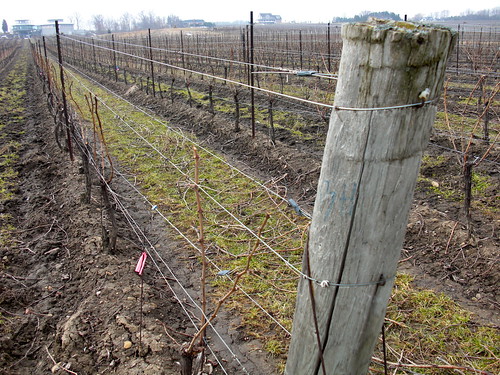
It’s an uncompromising, regimental approach to winemaking that Madronich has implemented at Flat Rock since its founding in1999 on a gorgeous piece of the Niagara Escarpment known as the Jordan Bench. The Rock has some of the most stunning views in Niagara, with the vineyards and Toronto in the distance from the patio and glass-encased tasting room.
It all starts in the 80 acres of Flat Rock vineyards with low yielding vines (chardonnay, pinot noir, riesling and a bit of gewürztraminer), and the hand picking and sorting of the grapes. The process continues through crushing at the winery’s modern and clean gravity flow operation.
Once the grapes are crushed they go directly into state-of-the-art 4.5-tonne temperature controlled stainless steel fermenters.
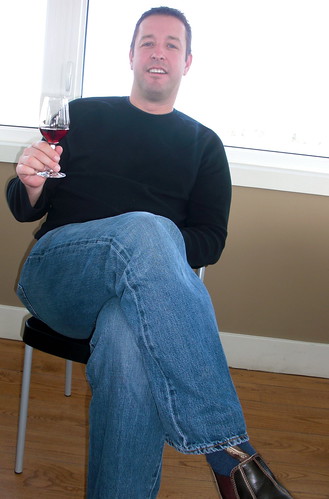
The juice and skins for the pinots are hand-plunged every six hours to extract maximum colour and tannin without over-extracting bitter character. Post fermentation, the wine is run directly to the lower level barrel cellar where it is aged in 100% French oak barrels (for pinot and chardonnay) and awaits malolactic fermentation in the spring.
THE WINES:
Flat Rock Cellars makes wine out of the varietals it feels grow best on the Twenty Mile Bench. And that’s pinot noir, chardonnay and riesling (and a tiny bit of gewürztraminer).

There are two tiers of wine within each variety: Reserve and Estate. Rusty Shed and Gravity are Reserve wines identified by unique names.
The estate wines highlight the individual variety. The Reserve wines — created from sub blocks in the vineyard that express exceptional purity of fruit — are intricately layered and show depth, while the Estate wines provide a fruit forward, easy-drinking wine experience, according to Madronich.
THE TASTING NOTES:
I am led to the sun-drenched tasting room on the top floor of the winery where the view through the penthouse windows is breathtaking.
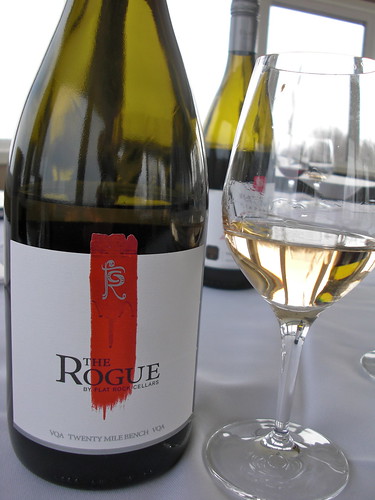
Madronich has set up an extensive tasting of new and old wines to try, beginning with yet another unique offering from this innovative winery (which was first to go all screwcaps, first in Niagara with a sparkling wine using a crown cap, first in Niagara to develop a tasting room iPad app, first to team up with a gourmet food truck, etc.). And now this. He shows me The Rogue, A pinot noir that’s white and plays like a chardonnay but is distinctly pinot. A white pinot noir? Leave it to Madronich and Flat Rock to rock the boat one more time.
Here’s what we tasted over a morning of tasting.
Flat Rock Cellars The Rogue Pinot Noir 2009 ($35, winery only, 89 points) — This white pinot was “made to honour my dad (Ed Sr.) who doesn’t always accept the way things are done. He instilled that in me,” says Madronich. It’s 100% estate pinot made with very little skin contact, barrel fermented, aged and finished unfined and unfiltered.
It has deceptive white wine characteristics on the nose with some stone fruit notes to go with red berries, vanilla and creamy aromas. It’s smooth and silky on the palate with strawberry-cherry flavours and creamy, sweet vanilla. A truly unique wine unlike anything else being made in Niagara.
Flat Rock Cellars Estate Pinot Noir 2009 ($20, winery and Vintages, 88 points) — Still a young wine but shows gorgeous raspberry-cherry fruit, earth and spice on the nose. It opens up in the mouth with vibrant red fruits, spice, minerality and lovely oak tones.
Flat Rock Cellars Estate Chardonnay 2008 ($17, winery, 90) — This is one heck of a chard for $17. The nose oozes minerality, tropical fruit and nuanced oak and spice. Lovely in the mouth with bright tropical fruits accented with citrus and minerals.
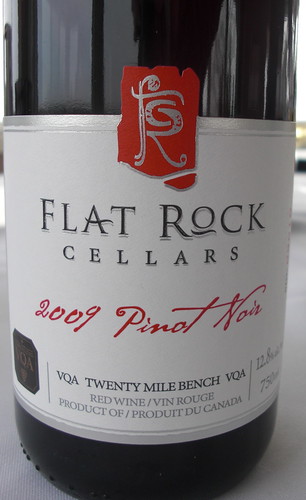 Flat Rock Cellars Reserve Chardonnay 2008 ($35, winery soon, 92 points) — This is a top flight “reserve” chard only made in the very best vintages at Flat Rock. It shows elegance right from the get-go with subtle lime-citrus fruit and layered notes of vanilla, mineral and spice. The mouth reveals beautiful notes of citrus and soft peach to go with fine oak styling, mineral and length through the finish.
Flat Rock Cellars Reserve Chardonnay 2008 ($35, winery soon, 92 points) — This is a top flight “reserve” chard only made in the very best vintages at Flat Rock. It shows elegance right from the get-go with subtle lime-citrus fruit and layered notes of vanilla, mineral and spice. The mouth reveals beautiful notes of citrus and soft peach to go with fine oak styling, mineral and length through the finish.
Flat Rock Cellars Riesling Reserve 2009 ($30, winery and Vintages Classic Collection, 92 points) — This remarkable reserve riesling from Flat Rock is sourced from a small lot within the estate vineyards. This is the first vintage for the new “red label” reserve wines. The wine uses a mix of wild and cultured yeasts and went through partial malolactic fermentation. It’s a weighty, powerful riesling done in the Alsatian style with vibrant citrus, developing petrol notes and wet stone minerality. It’s complex, bold and has wonderful length on the finish. A real treat that will develop beautifully in the cellar for 10 years or more.
Flat Rock Cellars Nadja’s Vineyard Riesling 2010 ($20, released in late May, 92 points) — Sourced from the most southern block of riesling (named after Madronich’s mother), this is a defining riesling for Niagara. It’s just been bottled so needs time, but already showing classic Nadja aromas on the nose — grapefruit, lime, citrus and melon fruits with a gorgeous mineral note through the core. It’s more opulent than previous vintages but maintains firm acidity in the mouth and juicy citrus flavours.
Madronich also poured some back vintages of Nadja’s including the 2008, with petrol, lanolin and fresh-squeezed citrus notes, the 2006 vintage, an outstanding aged riesling with classic petrol, mineral, and depth of flavour, and the extraordinary 2004 Nadja’s, with stoney minerality, petrol, layers of softening fruit, cream and showing no signs of weakening. A treat to taste them all back to back and proof that Niagara rieslings are best when left in the cellar for a few years.
Flat Rock Cellars Estate Riesling 2009 ($17, winery, 89 points) — The estate riesling is made with a touch of sweetness to. The nose shows peach, tangerine and honey notes with a squirt of lemon zest. The mouth reveals juicy fruits with a kiss of honey.
Madronich finished off the tasting with some aged estate rieslings including the 2007 vintage, which was starting to show its age, and the stunning 2005 vintage, with gorgeous, voluptuous orchard fruits, mango, honeycomb, petrol and mineral notes all perfectly balanced. This is why I love riesling so much.
Enjoy!


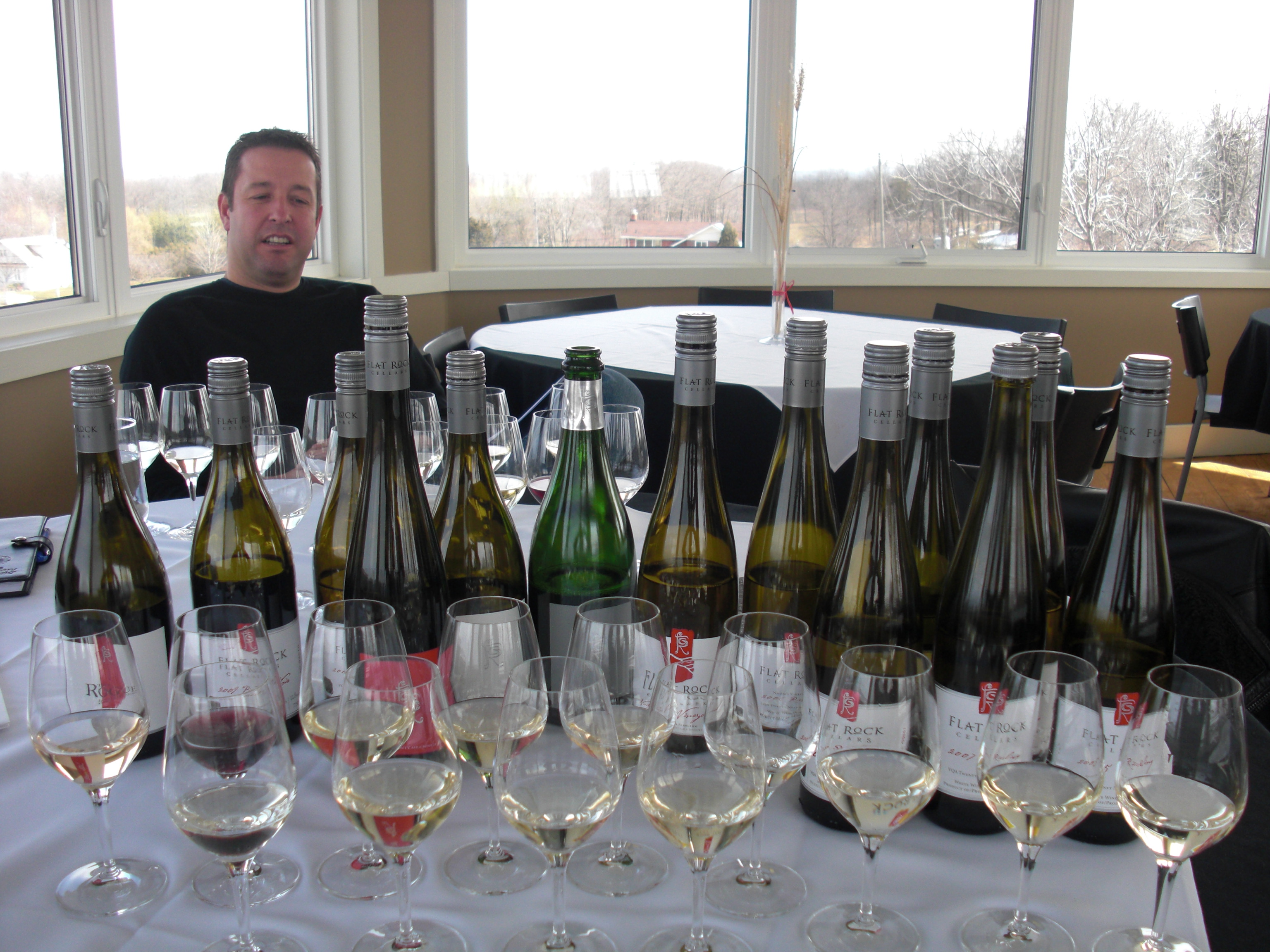



Comment here